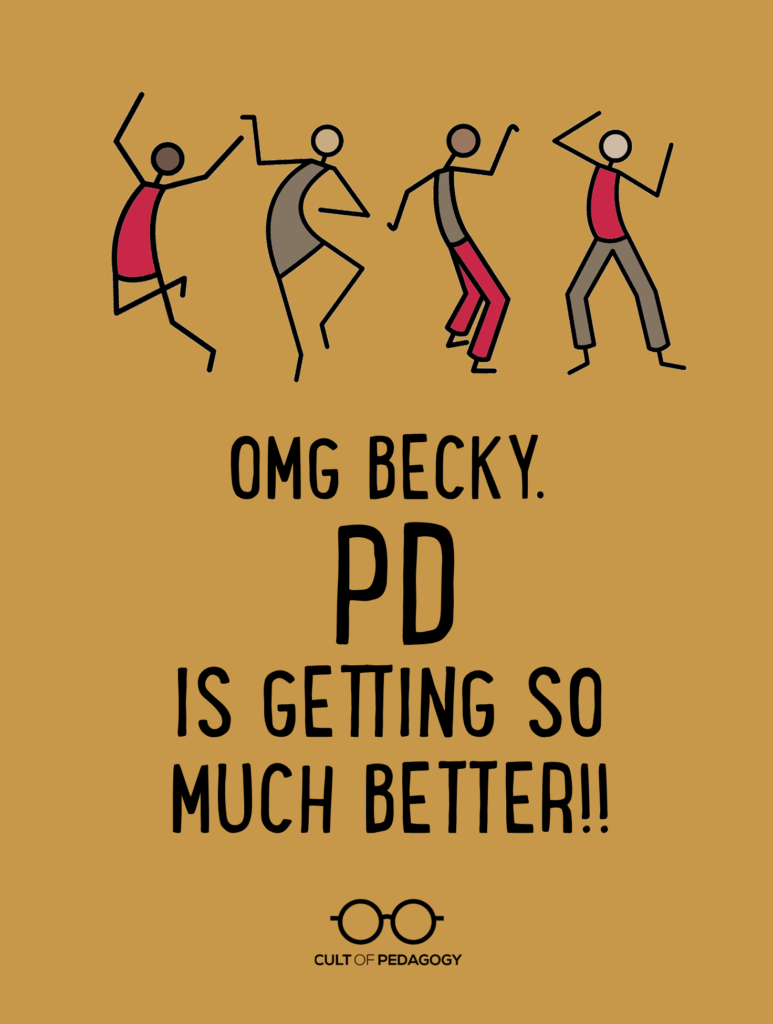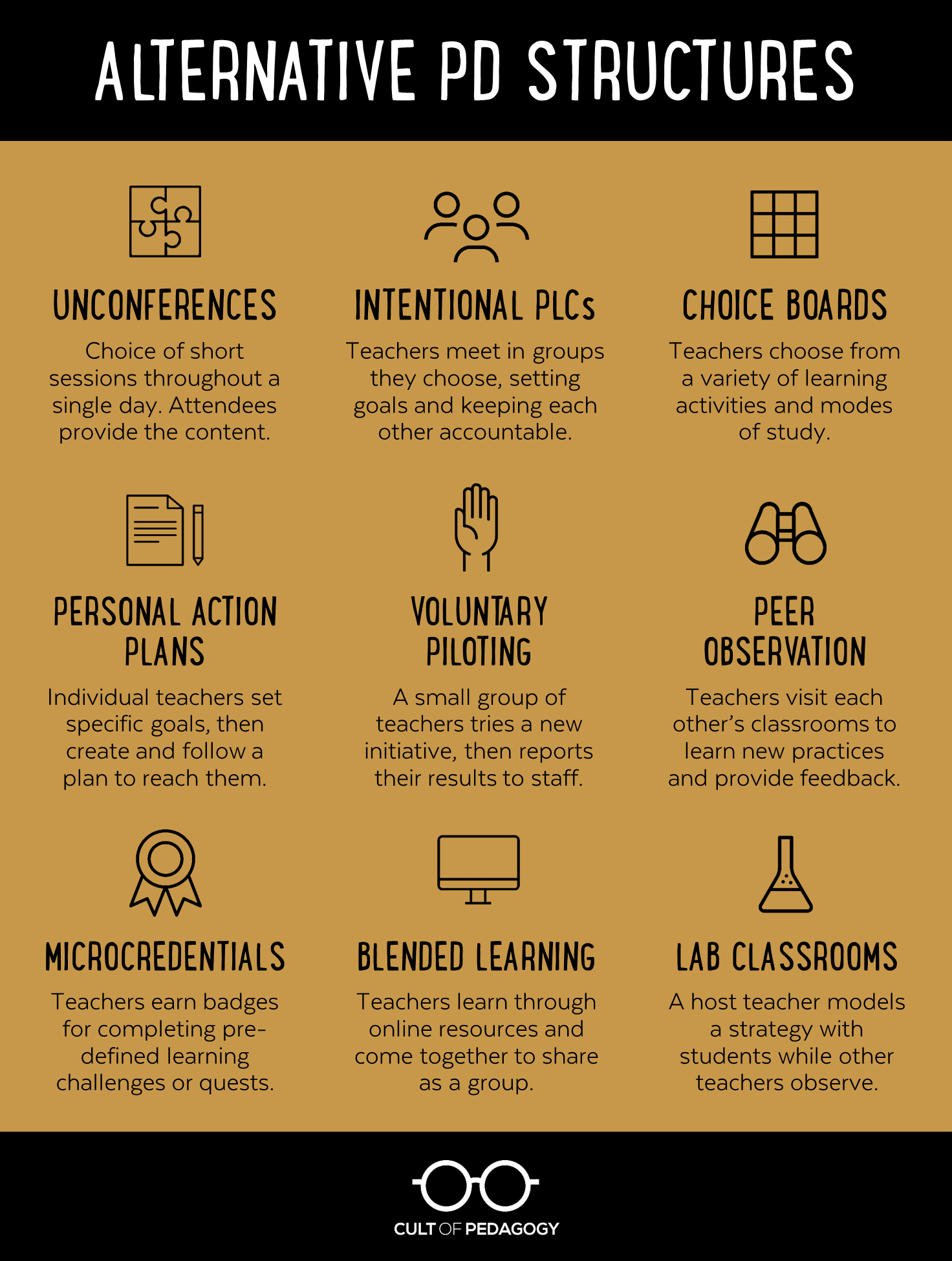
Listen to this post as a podcast:
Sponsored by Pear Deck and Peergrade
I literally can’t even wrap my head around all this stuff. Just a few days ago, I popped onto Twitter and asked people to share their ideas for alternative PD structures.
Holy cow.
As I put this together, the responses are still trickling in. I started down this path thinking that lots of districts were still stuck in a one-size-fits-all, sit-and-get, whole-school PD model, where the entire staff is herded into one room to listen to one expert talk. I’ve been the person on that stage, and even in the best of circumstances, I still get that uncomfortable feeling when I look out over the crowd and see the folded arms, the faces turned down to screens, the bouncing, bored feet. It sucks to be the presenter in those situations.
But evidently, that model is disappearing. Because person after person told me about all the innovative ways their schools and districts are reinventing professional learning for teachers. I’ve done my best to curate a good list of those ideas here, but honestly, it was like trying to drink from a fire hose. After a while, I just told myself I was going to have to stop collecting and just get the big ideas out there. If you really want to do a deep dive on any one of these, go to that Twitter thread and follow up with some of the people who shared their practices. (And if you haven’t joined Twitter yet, read this.)
What I have for you is a list of 9 alternative models for teacher professional learning. All of these are being tried in different schools, some informally, and some are really well-developed at this point. Many schools are using a combination of them. It’s just incredible. A feast, really. I’m so excited and encouraged to see so many schools willing to personalize learning for their teachers. Lately it has seemed that this is a really sucky time to be a teacher, but I’ll tell you, if there’s one thing that is actually getting better about teaching, I’m pleasantly surprised to say that thing is professional development.

1. Unconferences
How They Work
You might know these as EdCamps or TeachMeets, but the principle is the same: An unconference is a grassroots conference where the content is provided by the attendees themselves—not outside experts. It used to be that these were organized primarily as separate events from “official” school PD, but now administrators are bringing the model in-house to BE the actual PD.
Although there are variations, unconferences basically work this way:
- A time and day are chosen, along with a venue (probably your school), where available rooms for sessions are identified.
- Using a spreadsheet (a Google Sheet is ideal), the day is divided into short blocks of time. Sometimes these are just 20 minutes long, other times they may be up to an hour.
- People volunteer to run sessions based on their areas of expertise or things they have learned: teaching methods, tech tools, etc.
Example
- Klein Cain High School in Klein, Texas, hosted a PD Carnival that combined the structure of an unconference with a Halloween costume contest and carnival-style games at lunch. The day’s organizers didn’t have to add on these two things; they could have just had a regular unconference and the staff probably would have been happy just to have a different format. But the costume contest and games at lunch made memories for the staff and gave them a different opportunity to bond. These things matter: Giving staff and students opportunities to bond makes a huge difference in school culture; a lack of effort in this area can create the kind of school people want to leave.
- English teacher Will Melvin shared the Genius Bar approach used by Central Bucks High School South in Warrington, PA: “Once a month teachers present mini-lessons to other teachers on different best practices. Each teacher rotates through 2-3 sessions and can engage with the teacher presenter to learn.” Teachers sign up to present through a central OneNote notebook, then other teachers choose their sessions from that menu. Take a look at one schedule of sessions on formative assessment.

2. Intentional PLCs
How They Work
The concept of the professional learning community (PLC) has had wide interpretations, but in many places it has defaulted to a grade-level or content-based team. In some schools, however, teachers join PLCs with more deliberate intentions. When PLCs are chosen by teachers based on a shared interest or a mutual commitment to growth they get much better results.
Example
- Pennsylvania’s Gettysburg Area High School switched to themed PLCs this school year. The PLC focus areas were determined ahead of time by the principal—topics like formative assessment and hybrid teaching models—then teachers sign up for the one they want. PLCs then set their own goals and timelines for meeting them. Christina Godard, a reading specialist and special educator at the school, prefers this over the former one-size-fits-all model. “I enjoy having choice in professional development and the opportunity to develop it into what we need and will benefit us at the time.”
- Masterminds are small, intimate groups of educators that regularly meet in person or online to set goals, talk through problems, do book studies, and hold each other accountable for growth. Middle school principal Danny Bauer runs a number of masterminds online. Learn more about how educator masterminds work in my podcast interview with him.

3. Choice Boards
How They Work
Teachers are given a menu of PD options to choose from. Depending on their district, they may be required to complete a certain number of options within a certain period of time.
Examples
- At Big Spring High School in Newville, PA, teachers choose one option from a Best Practice Group Choice Board—created this school year by instructional coach Niki Donato—and that one choice serves as their PD for the school year. Each option requires a twice a month time commitment of some sort, but there’s lots of variety in how they spend that time. Principal Bill August says the staff has responded well so far “because it is timely and tied to their immediate planning and teaching. Also, it is an overhaul of what we were doing, which was far more whole group, one size fits all.” As a coach, Donato sees a big difference this year. She used to meet with teachers in groups based on planning periods. “I felt as though I wasn’t coming close to meeting their individual needs,” she says. With this new model, she sees a whole new level of enthusiasm. “Many teachers talk about their instruction with me more than what is required.”
- At Westfield Middle School in Bloomingdale, IL, assistant principal Nicole Gabany and Instructional Technology Coach Nanci Greene introduced a DIY PD Bingo Board to their staff this year. The board contains lots of different choices for short learning activities. “I think a lot of our staff were doing some of these on their own,” Gabany says, “but it was nice for them to recognize what they do independently and for us to see since they wouldn’t always share those things.” They created a whole-staff board where teachers would place dots on activities they’d completed, so they could see where they were as a school.

4. Personal Action Plans
How they Work
In this model, individual teachers set their own personal learning goals, along with a specific plan for reaching them. Often, there is also a plan for making their results public with colleagues.
Examples
- Cohort 21 is a year-long professional development opportunity hosted by an association of independent schools in Ontario, Canada. In the program, teachers meet four times from October through April to design and implement personal action plans.
- Many schools, like Noble Crossing Elementary in Noblesville, Indiana, have implemented their own teacher Genius Hour. Teachers are given regular time to pursue specific, teaching-related interests. “Topics are selected at the beginning of the year,” says instructional coach Lauren Smith. “Then during our district early release days, in lieu of typical PD, teachers and staff have time to work toward their learning plan either independently or with a learning team. Throughout the process there is time to reflect and adjust learning plans or even topics. Some teachers and staff will either switch topics, or start a new topic if they feel their current project has run its course.”

5. Voluntary Piloting
How it Works
Rather than requiring a whole school to adopt some new initiative, a small group of committed, interested teachers volunteers to take on the task of trying out the new approach.
Example
Krista Taylor and her colleagues at James N. Gamble Montessori High School in Cincinnati, OH, launched a voluntary piloting program to get better at differentiation strategies. In this post, she explains how the process worked and how much everyone involved benefitted from it: “Those of us in that original pilot group have achieved our original vision of classrooms where differentiation has become a norm,” Taylor writes. “Meanwhile, other members of our faculty have followed our lead, and differentiation strategies are being implemented at different levels throughout our building.”

6. Peer Observation
How it Works
Teachers take advantage of the best source of free professional development available: each other. By watching their own colleagues teach during classroom visits, teachers learn things they can immediately apply in their own work. If they have follow-up questions, the experts are right down the hall.
Examples
- Using the Learning Walks model, small groups of teachers visit several classrooms in succession, observing with a particular lens. For example, they might be looking at student engagement or ratios of teacher talk to student talk. After each visit, the group debriefs about what they learned. Watch a learning walk in action in this video.
- Hundreds of schools have started using Pineapple Charts to learn and grow together. These central calendars advertise what’s happening in classrooms all over the building, so teachers can pick and choose the ones that are most interesting to them, then just drop in for a visit. Learn more about Pineapple Charts in this post or search the #pineapplechart hashtag on Twitter.
- In the U.K., Paul Garvey has developed the Talk for Teaching protocol, where teachers observe one another and debrief afterwards with the support of an instructional coach. This approach is explained in Garvey’s book, Talk for Teaching: Rethinking Professional Development in Schools.

7. Microcredentials
How They Work
Teachers earn “badges” or microcredentials for completing challenges or learning pathways that have been created ahead of time, usually online.
Example
- Lucas Gillispie, Director of Academic and Digital Learning for Surry County Schools in North Carolina created Epic Academy, a “game-inspired professional development program in digital learning.” On the platform, teachers choose quests based on their interests. Within each quest, teachers complete tasks and unlock the next level of a quest until they reach mastery.
- Teachers in Liberal USD 480 in Liberal, Kansas, can get their PD through a medal system on their district’s Innovation Factory. This system of leveled challenges, where teachers all study the same topic but choose which level of difficulty to tackle, was created by instructional coach Virginia Duncan and technology integration coach Kate Piland. Check out this 4-level challenge on shifting student mindsets, which includes a combination of online and in-person learning, plus different choices for sharing your learning.

8. Blended Learning
How It Works
Taking advantage of all the great learning management systems available, some schools are offering some of their PD online. Teachers can do the required modules on their own time, then submit some sort of evidence of completion to get credit for the work. Staff may meet in person to debrief or they may be excused entirely from face-to-face meetings, depending on the requirements.
Example
Lynn Cashell, a teacher in Garnet Valley, PA, describes how her school uses a blended model using Schoology: “There are two courses posted in Schoology. As teachers complete the courses, we upload lessons or other required elements. Admin reviews (and grades) the work.” If teachers choose not to do the course on their own time, they can also take it in person on the scheduled inservice day. This flexibility allows teachers to choose what works for them. “This allows us to come in late or leave early on District Inservice days as long as we have met the requirements,” Cashell explains.

9. Lab Classrooms
How They Work
A host teacher demonstrates a strategy in his or her own classroom, with students, while visiting teachers observe. The process typically includes some pre-observation work, co-teaching with an instructional coach, and a debriefing after the observation. This article from ASCD’s Educational Leadership explains how it works in more detail.
Example
- Noble Crossing Elementary School in Noblesville, Indiana, has seen great results with lab classrooms. Instructional coach Lauren Smith says they offer two types: “mini” labs that are a half day and focus on a single skill, such as conferring in reading workshop, and day-long “mega” labs that focus on larger protocols, like a whole reading workshop. “Every teacher will have either experienced a mini or mega lab by the end of the school year,” Smith says. “This form of PD has been well received from my colleagues and they have expressed seeing and doing an instructional strategy alongside their colleagues and actual students is one of the best forms of collaboration.”
- Carrie Alday, Director of Elementary Curriculum at Westfield Washington Schools in Westfield, Indiana, shared her school’s Build-a-Labs model on Twitter. “You go in a classroom and someone can model a teaching strategy like a reading conference,” she explains. “After the short model, the other teachers then grab a student and try out a reading conference right there. This can be used for lots of different purposes.”
A Final Thought: Start Somewhere
If you are in a district that is stuck in a PD rut and you feel like there’s no chance they’d ever be willing to try something new, I want to encourage you to have hope. Pass this along to the people in charge. And let them know that a complete overhaul is not necessary: Even trying one or two of these ideas on a small scale would be a great start.
If no one bites, try something yourself. Yes, you’ll still have to sit through PD that feels irrelevant, but no one’s stopping you from getting your own PD on top of what you’re required to do. Find a small group of enthusiastic colleagues, pick an option, and just try it. If you get good results, share them with your staff. Sometimes all it takes is one brave person to stand up and say, Look everyone, I tried this, and it was good.
You can be that person. Go try something. ♦
Join my mailing list and get weekly tips, tools, and inspiration that will make your teaching more effective and fun. You’ll get access to our members-only library of free downloads, including 20 Ways to Cut Your Grading Time in Half, the e-booklet that has helped thousands of teachers save time on grading. Over 50,000 teachers have already joined—come on in.






Wow! I love these PD frameworks – so creative. My dissertation project on Scaffolding Regulation Skills attempts blended learning and can be incorporated into larger PD efforts: http://sites.psu.edu/educatems/scaffolding-regulation-skills/
All of these would be GREAT starts, but most end up being a one-and-done autonomous event unfortunately. The Professionally Driven model looks to build sustainable autonomy while allowing intrinsic motivation to drive an active process of developing our educator growth mindset -> professionallydriven.com.
Jarod has a good point – PD is best when it is ongoing rather than a once and done. And learning from each other is helpful, but learning from professional trainers who are experts, not relative experts, is so much better.
Thank you for this summary, Jennifer. I would like to suggest #10. Coteaching – When classroom teachers and school librarians (for example) coplan, coimplement, and coassess learning outcomes and their instruction, they learn with and from each other. Both educators are actively involved with students (thereby lowering the student to educator ratio at the point of need). This form of job-embedded professional development is not one-size-fits-all and leads to repeat opportunities to codevelop instructional expertise with actual students and available resources based on the taught curriculum and with the supports and constraints of the school schedule.
I enjoyed every minute of this podcast and having taken notes. Love all of the creative strategies and your concise descriptions. Thank you so much for your work on this topic. I am also now following you on Twitter!
My school did cohort PD this year and while it could use a little tweaking (first-timers!) it was wonderful. A dozen different topics were chosen by the admin and we were able to join whichever group interested us most. Then it was up to us to direct our group, bring in experts if we wished, then share what we’d learned (and actually done with our new-found knowledge) with the rest of the school at our last PD day for the year.
Having a choice, being invested in the topic, and directing all our own learning (things we want for our students, too) was the BEST!
Nicole Gabany (DIY PD BINGO) here, just listened to the podcast and 16:12 wanted to drop a line and say YES!!! You are saying my name right! 😉 Thanks for all the GREAT resources!
I will be sharing these with the instructional technology coaches in our district to inform and shape our plans for PD in the coming school year.
Variety and choice seem to be what teachers in our district are asking for and with these recommendations I am hopeful that we will be able to deliver.
Hi Jennifer! My school (Klein Cain HS) is mentioned in this post for our PD Carnival idea. Thank you so much for sharing ours and so many others. We were inspired by so many!
Because we were so inspired, we borrowed a few more ideas from that post and created a new form of PD for a final 9 weeks challenge, called the Cain PPL (Personalized Professional Learning) Bingo Challenge. You can read all about it and see pictures and resources in the article I’ve linked below. I thought I would share it with you since I was inspired by you and others to implement it. Hope you like it, and feel free to share!
https://theexchange.kleinisd.net/passionate-professional-learning-at-klein-cain-hs-43e052e6410a
Unfortunately, the powers that be do not trust teachers to be left to their own devices. Thus, forced PD. I am working to make Microcredentials part of our PD framework in our state. Scary as it may be, teachers get to choose their PD and practice it in their classroom! Wow!
Thank you very much for compiling and sharing these ideas about new structures for PD. My district is trying an Unconference this August and we are very excited about the learning possibilities for this new approach. I will also share these ideas with my curriculum team and my graduate students. Thank you, thank you!
I am the Gifted and Talented Facilitator and part of my job is to provide PD for helping teachers differentiate in their classrooms. I had a lot of teachers signing up for my Book Studies and Differentiation classes. We had a lot of great discussions and it felt like it was useful, but when I worked in their classrooms I saw that not a whole lot was changing about the way they taught. I was pretty discouraged until I found Lesson Study
http://www.americanradioworks.org/segments/a-different-approach-to-teacher-learning-lesson-study/
The teachers who are doing lesson study are really implementing the strategies that we work on. It’s awesome. I will never go back to regular PD.
Thanks for sharing Miriam. Lesson study seems like a kind of collaborative action research. I’ve worked with English teachers in Southeast Asia, helping them to take ownership of their professional development as teachers through conducting action research. While our teachers went through this process in their individual classes and shared the results with their teaching community, I like how lesson study incorporates the teaching community from the very beginning of the process. Very cool!
I’m so glad you mentioned Lesson Study. In Texas, we are taking it statewide. It’s an amazing form of job-embedded, teacher-driven, ongoing form of professional development. I’ve heard it called PLC on steroids. It’s the most empowering form of PD I’ve ever experienced. I hope others can get connected with Lesson Study and experience this amazing transformation of true PD that focus on student learning outcomes as evidence of success. Teachers begin to see learning through the eyes of children. Focus moves from “What am I teaching?” to “What are students learning”. Such a simple shift, with powerful results.
Thank you for sharing about Lesson Study and for posting the article. This looks like another great PD structure and I am glad to see it has worked effectively for you.
I stumbled across this post as I was doing an assignment for a leadership course I am taking at Walden University and…wow! I loved looking at each of these PD models and thinking about how I could incorporate that into my school. As part of various teams at my school, we are always looking for new ways to structure professional development instead of just the boring “expert at the front”. As I am planning to do another PD session in March, I will definitely be trying out one of these structures!
So glad to hear this, Alex!
This post on PD has opened my eyes to something. My district is doing so many of these great things. The challenge is that we haven’t let go of the other PD type events. We can’t do it all! Seeing peer observations, EdCamp participation, etc should be considered options to the development of an experienced teacher. New teachers may have fewer options because of all they need to be familiarized with. I’m looking forward to having some conversations that allow for choice.
So glad this shed some light, Sheri! Hope it leads to some meaningful dialogue.
Does anyone have resources they can share on Intentional PLCs? I’d love to share this with my school!
Hi Sarah,
Check out What is an Educator Mastermind, and Why Should You Join One? Hope this helps!
I am glad to see that you think professional development is getting better. A ton of people have told me that professional development is not necessary. But I agree with you and think they’re wrong, especially because of how it is improving.